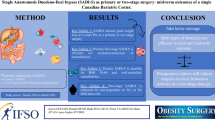Abstract
Background
An ileostomy is usually created to avert systemic sepsis in a patient with a tenuous anastomosis. However, what is often not reported are the numerous issues facing these patients subsequently, ranging from readmissions, non-reversal of the stoma, and complications from the closure. This study was performed to identify these issues among patients following creation of an ileostomy.
Methods
We conducted a retrospective analysis of consecutive patients who had an ileostomy created from January 2011 to December 2016 at two institutions. Statistical analysis was performed to identify risk factors associated with readmissions and ileostomy non-reversal.
Results
In total, 193 patients had an ileostomy created during the study period. Twenty-six (13.5%) patients developed stoma-related complications requiring readmission. The most common cause of readmission (9.3%) was due to dehydration and acute kidney injury secondary to high stoma output. One hundred thirty (67.4%) patients had their ileostomy reversed. On multivariate analysis, only stomas created during an ultra-low anterior resection were associated with reversal (OR 2.88 [95% CI, 1.24–6.68]; p = 0.014). Among the patients who underwent ileostomy reversal, seven (3.6%) patients developed complications from their ileostomy reversal. Four patients (2.1%) suffered from an anastomotic leak which required repeat surgical intervention with one mortality from the ensuing sepsis.
Conclusion
Almost half of the patients who had an Ileostomy had an undesirable outcome, including readmissions, non-reversal, and post-operative complications following closure. Patients need to be properly counselled about the risks involved prior to the index operation.

Similar content being viewed by others
References
Lightner AL, Pemberton JH (2017) The role of temporary fecal diversion. Clin Colon Rectal Surg 30(3):178–183
Li L, Lau KS, Ramanathan V, Orcutt ST, Sansgiry S, Albo D, Berger DH, Anaya DA (2017) Ileostomy creation in colorectal cancer surgery: risk of acute kidney injury and chronic kidney disease. J Surg Res 210:204–212
Löb S, Luetkens K, Krajinovic K, Wiegering A, Germer CT, Seyfried F (2018) Impact of surgical proficiency levels on postoperative morbidity: a single centre analysis of 558 ileostomy reversals. Int J Color Dis 33(5):601–608
Yilmaz E, Çelebi D, Kaya Y, Baydur H (2017) A descriptive, cross-sectional study to assess quality of life and sexuality in Turkish patients with a colostomy. Ostomy Wound Manage 63(8):22–29
Gastinger I, Marusch F, Steinert R, Wolff S, Koeckerling F, Lippert H, Working Group ‘Colon/Rectum Carcinoma’ (2005) Protective defunctioning stoma in low anterior resection for rectal carcinoma. Br J Surg 92(9):1137–1142
Paquette IM, Solan P, Rafferty JF, Ferguson MA, Davis BR (2013) Readmission for dehydration or renal failure after ileostomy creation. Dis Colon Rectum 56(8):974–979
Messaris E, Sehgal R, Deiling S, Koltun WA, Stewart D, McKenna K, Poritz LS (2012) Dehydration is the most common indication for readmission after diverting ileostomy creation. Dis Colon Rectum 55(2):175–180
Li W, Stocchi L, Cherla D, Liu G, Agostinelli A, Delaney CP, Steele SR, Gorgun E (2017) Factors associated with hospital readmission following diverting ileostomy creation. Tech Coloproctol 21(8):641–648
Gunnells DJ Jr, Wood LN, Goss L, Morris MS, Kennedy GD, Cannon JA, Chu DI (2018) Racial disparities after stoma construction exist in time to closure after 1 year but not in overall stoma reversal rates. J Gastrointest Surg 22(2):250–258
Chow A, Tilney HS, Paraskeva P, Jeyarajah S, Zacharakis E, Purkayastha S (2009) The morbidity surrounding reversal of defunctioning ileostomies: a systematic review of 48 studies including 6,107 cases. Int J Color Dis 24(6):711–723
Bhama AR, Batool F, Collins SD, Ferraro J, Cleary RK (2017) Risk factors for postoperative complications following diverting loop ileostomy takedown. J Gastrointest Surg 21(12):2048–2055
Luglio G, Pendlimari R, Holubar SD, Cima RR, Nelson H (2011) Loop ileostomy reversal after colon and rectal surgery: a single institutional 5-year experience in 944 patients. Arch Surg 146(10):1191–1196
Faunø L, Rasmussen C, Sloth KK, Sloth AM, Tøttrup A (2012) Low complication rate after stoma closure. Consultants attended 90% of the operations. Color Dis 14(8):e499–e505
Author information
Authors and Affiliations
Corresponding author
Ethics declarations
Institutional Review Board (IRB) ethics approval was obtained for this study.
Additional information
Publisher’s note
Springer Nature remains neutral with regard to jurisdictional claims in published maps and institutional affiliations.
Rights and permissions
About this article
Cite this article
Chan, D.K.H., Ng, J., Koh, F.HX. et al. Journey for patients following ileostomy creation is not straightforward. Int J Colorectal Dis 34, 2075–2080 (2019). https://doi.org/10.1007/s00384-019-03428-6
Accepted:
Published:
Issue Date:
DOI: https://doi.org/10.1007/s00384-019-03428-6




